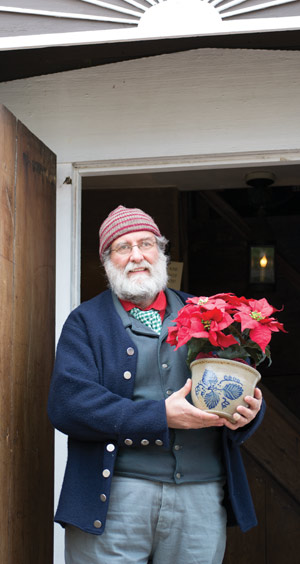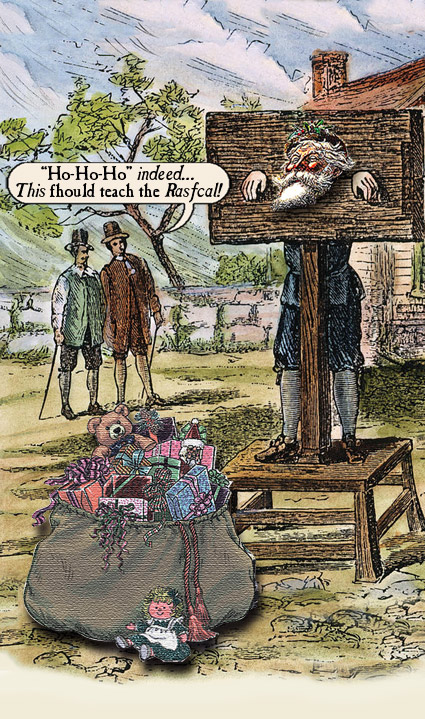
By Debbie Gardner
debbieg@thereminder.com
The Christmas tree goes up just after Thanksgiving – or maybe even, a little before. Poinsettias spill from every surface, along with garland and lights and perhaps, a jolly red Santa or two. Beneath that tree, brightly colored gifts are piled high while carols – from modern takes on old favorites to classic hymns – set the soundtrack of the season, spilling wirelessly from blue-toothed speakers transmitting Pandora holiday channels.
It’s Christmas in America. Some say it’s too commercial. Many lament the hustle and bustle, longing for the simpler pleasures of an old-fashioned holiday.
But what does an “Old Fashioned Christmas” really mean?
According to Dennis Picard, museum director at Storrowton Village, located on the grounds of the Eastern States Exposition in West Springfield, Mass., that depends.
“Take two different people and to each of them, an old-fashioned Christmas is the one that their oldest living relative remembers,” Picard said. “We have a short memory when it comes to history.”
When there was very little Christmas

Like much of our American culture, the celebration of Christmas is a melting pot, blending together the traditions of those who came to her shores.
Early on, Picard said, there was very little attention paid to Christmas in America, especially in the Northeast.
“A lot of people single out Christmas, but it was all the holidays that had been added to the religious calendar over the years, there was no celebration of Easter, Michaelmass, the holy days. The early churches wanted to eliminate those,” Picard said. “Think about the names of the religious groups that first came here, like the Pilgrims. They deliberately chose that name because they were seeking the truth and the truth was to bring the church back to primitive times.”
But Christmas wasn’t completely overlooked by the colonists, Picard said. Some groups did recognize the day.
“[The Anglicans] did have Christmas on their calendar still, they had never eliminated Christmas. We do know some Anglican churches in coastal areas and rural area and even out in Granville [Mass.] and North Granby, Connecticut, had small Anglican populations and they celebrated Christmas.”
The holiday got more of a boost in the early 19th century, Picard noted, when the “influx of immigrants from Europe, especially Catholic immigrants that had never stopped celebrating [Christmas],” began to reintroduce the idea of celebrating the religious holiday back to America.
“The Yankees made fun of them,” Picard said of the Irish, French and French Canadians who carried on their traditions and taught them to their children.
At that time celebrating Christmas also became a political hot button, with workers wanting the day off to celebrate, and mill owners, who where mostly old-school Congregationalists, feeling it was not necessary.
Trees and gifts and Santa, oh my!
“What we would recognize as a Christmas today really came around the Civil War, or just before, “Picard said.
He said around that time, churches began to loosen their strict standards on celebrations. He noted there was a report around the Civil War of a Second Baptist church bringing in a Christmas tree, hoping it might attract a younger congregation.
Picard said he also found a newspaper report from Chicopee, Mass., in the 1850s that “talked about Santa Claus coming to leave presents for children,” and other newspapers carrying photos of Queen Victoria’s Christmas tree in England.
However Picard credits Victoria’s predecessor, Queen Adeline, with introducing both the Christmas tree – and the use of plaid – to the then burgeoning holiday tradition.
The first documented New England display of what we would call a Christmas tree took place in 1832 when then Harvard University German instructor, the Rev. Charles Follen and his wife Eliza, erected a tree for their party guests.
“He wanted to share a bit of his German tradition, and people came to gawk at it,” Picard said. He added that it wasn’t until the second decade of the 20th Century that the Christmas tree became a standard part of America’s holiday tradition.
“It took almost 100 years to become common,” he noted.
Gift giving around the holiday season has always existed in America, Picard said, with the tradition going back to Revolutionary War time in New England. But it was not necessarily associated with Christmas.
“Back then, New Years was the big celebration, and it was common for women to exchange small gifts, such as hat ribbons or niceties for sewing,” he said, adding “you could give gifts at New Years without getting in trouble with your minister.”
Newspapers of the day even ran ads with New Year’s gift suggestions, he noted.
“Now you hear people say that Christmas gift-giving is too commercial, but Christmas has always been, in one aspect, commercial,” Picard said.
We can trace the roots of our modern-day Santa Claus to Washington Irving, a popular author and satirist of the early 19th Century, Picard said. Writing a tongue-in-cheek history of New York – then called New Amsterdam – Irving created a description of St. Nicholas – a Catholic saint purported to bring gifts to children on Dec. 6 in the Dutch tradition. His pamphlet was released on Dec. 6, 1809.
“St. Nicholas Day is in early December, it sort-of got rolled into late December” as the Christmas tradition grew during the Victorian Era, Picard said.
He noted that Victorian Santas – the type that Storrowton now depicts during its annual Yuletide celebration in early December – were often dressed in blue, or purple, or brown.
St Nicholas – who originally rode a horse – acquired a sleigh, Picard noted, when he “got combined” with the Norse god, Oden, as the Catholic church moved its influence north and absorbed some aspects of the gods of the area.
Santa became a “jolly elf” when once again, he got combined with elements of the English “Father Christmas” – a portly figure usually depicted with a wreath of holly on his head and a wine goblet in his hand.
“[Father Christmas] was more of a party person,” Picard said. “An embodiment of Bacchus, the Greek god of wine.”
In 1862, the artist Thomas Nast, drawing for the magazine Harper’s Weekly, created what became our image of Santa Claus, drawing him as a rotund, robust man with a white beard.
Santa became the now-familiar jolly old elf with a red suit in the 1930s, when Coca Cola used his image as part of their holiday campaign, Picard said.
Of carols and poinsettias
Once again, we can thank the Victorian era for what we consider a staple of our holiday tradition, singing carols at Christmastime.
Picard explained that, in their quest to return the church to its pure roots, the Pilgrims and Puritans – forerunners of New England Congregationalists – initially forbid singing in church.
“When [these churches] began to do singing, it was the Psalms,” Picard said.
In the 1830s and 40s, English carols started creeping slowly into some churches, patterned on the Victorian model.
The custom of caroling from house to house copied the English custom of wassailing – in which carolers traveled from farm to farm singing to invoke a better harvest. They were rewarded with food and drink, Picard said. ,
“It was a little more like Trick or Treat” than our modern image of caroling, he added.
The poinsettia – another common symbol of the modern holiday, came to America courtesy of Dr. Joel Roberts Poinsett, who served as an American ambassador to Mexico in the early 1800s. He became fascinated by the plant, and brought back samples, which he cultivated in his greenhouse in South Carolina.
Picard said the plant didn’t gain widespread popularity as a Christmas decoration or hostess gift until World War II.
“People today think it’s always been a part of Christmas,” he noted.
The American Christmas
Picard said the American idea of Christmas – the tree, caroling, Santa Claus and all – got exported around the world with servicemen during World War II.
And it’s a tradition that never stops evolving. Picard pointed out how Santa has changed with the times.
Santa Claus, he noted, was depicted as using the telegraph in the 1800s, the telephone in the 1930s and “now today Santa Claus has his own Facebook page.
“Writing a letter [to Santa] today is quaint,” he added.
Yuletide at Storrowton
Picard said Storrowton Village – the collection of 18th and 19th century buildings that recreate a traditional New England village green on the grounds of the Eastern States Exposition in West Springfield, Mass. – tries to capture the spirit of the early Civil War era Christmas celebrations through mostly natural-based decorations designed by local garden clubs. It also hosts caroling and often provides a Victorian era Santa for the children to visit.
This year Yuletide at Storrowton begins with a free two-day celebration Dec. 5 and 6 followed by guided tours Dec. 8 to 12, and a candlelight tour of the village on Dec. 9. The guided and candlelight tours have an admission charge of $5 per person.
For more information, visit www.thebige.com/sv/.